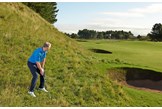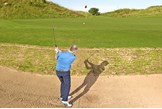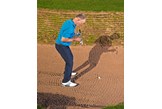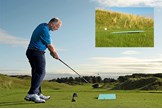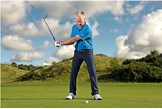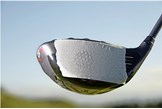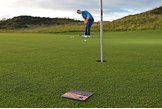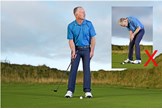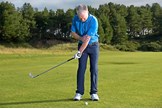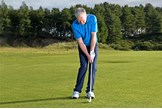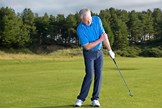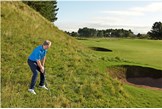9 strategy mistakes we all make and how to avoid them
Published: Last updated:
There are nine strategy mistakes we all make on the golf course: Here’s how to avoid them
We all have ideas about how we play the game, and where we lose shots… but how accurate are they? Thanks to modern shot data technology, we now know. Leaving approach shots shy of the green may be an accepted, common strategic error, but did you know the typical club golfer leaves four out of every five approaches short? Or that, on the greens, some 84% of putts over five feet also finish short of the hole?
RELATED: Strategy tips from the world’s best golfers
These are just two stats thrown up by data capture system Shot Scope, which regularly crunches the numbers from more than 30 million golf shots, played over hundreds of thousands of rounds. But the folk at Shot Scope have taken this further to identify the nine most common strategic errors we all make, round after round. Poor decision-making that costs us all shots.
The first step to fixing these mistakes is being aware of them; but we’ve also enlisted the help of TG Top 50 coach Adrian Fryer to deliver some targeted technical help to make sure you can capitalise on this information.
After all, when you ally a sharper technique to smarter thinking, you create a formidable shot-slashing combination.

STRATEGY ERROR #1: YOU DON’T HIT ENOUGH CLUB
You know it… but you still do it! According to Shot Scope’s database of more than 30 million shots, 80% of missed greens are missed short. To explain this more simply, on average a 20-handicap golfer hits four greens in reg per round. This means they miss 14 greens per round, and of those 14, 11 are missed completely short of the green altogether – a pretty staggering statistic.
Double trouble: Shot Scope’s mapping data reveals 72% of danger is at the front of the green (sand or water), whereas there’s only 28% behind. So missing long is significantly less of a problem than short. Stats reveal 96% of golfers play right-handed. Breaking their misses down in more detail, 47% miss short right compared with 33% short left.
There are three main reasons we miss greens short:
1. Not knowing how far you hit each club
Many golfers think they hit a 7-iron 150 yards, but Shot Scope V2, which records every shot hit on the golf course, shows the average golfer hits the ball nearly a full club shorter than they think they do. Knowing your on-course data gives you a more realistic outlook on how far you actually hit each club, as it is based on real shots, in real conditions on a real golf course.
2. Equipment
You need to have equipment that is forgiving enough for you. A more forgiving set of clubs will allow for the occasional mishit, and there will be less of a distance loss from
these strikes.
3. Ball-striking
All it takes is a little clip of the turf before the ball, or a toe/heel strike, to significantly impact the distance the ball will travel. These images provide an example of what a good strike would look like; a ball-turf strike ensures a clean strike and compresses the ball powerfully, helping you get it back to the pin.
RELATED: Five easy steps to lower scores
HOW TO FIX IT
Drill #1 Two-club challenge
On your next practice round, when the course is quiet, hit two shots into every green. On the first shot, hit the club you’d normally hit; for the second shot hit from the same place using one club more – for example, a 5-iron instead of a 6-iron. Hole out with both balls. Then, by the 18th, tot up your totals and compare the two scores. If you’ve done much better with the longer iron, that’s all the proof you need to club up.

Drill #2 ‘Fold, carry, hold’
Here is an easy three- step drill that will help you find that strong ball-turf contact. It works by training an arc into your swing that promotes a powerful, slightly downward strike.
Go through the positions in slow motion before moving up to full speed.
➤ Fold: Play the ball just forward of centre. As you swing back, feel your wrists cock and allow your trail elbow to fold. This sets up a compact swing, which helps you turn on top of the ball. It also creates powerful hitting angles.

➤ Carry: As you swing down, your weight moving towards the target, feel you’re carrying those wrist and elbow angles through to impact. You don’t want to be dumping these angles pre-strike; they keep your arc a little narrower, helping you deliver the club on a slightly downward angle.

➤ Hold: Through the ball, practise finding and holding this wide and extended position, those angles in the wrists and elbows expended. This gives your action that narrower-to-wider shape through the ball. With the widest part of the arc post-impact, you’ll be able to create a strong, compressing hit.

STRATEGY ERROR #2: CHOOSING 3-WOOD OVER DRIVER OFF THE TEE
Traditionally, the 3-wood has been seen as a safer alternative to a driver. Well, not according to the stats! Consider this data, based on all handicaps across 30 million shots. Yes, the 3-wood is just 1% more accurate than the driver.

This stat compares the distance of the two clubs. It is evident that, on average, a driver will go around 30 yards further than a 3-wood, which is probably what you’d expect. So the driver goes further, which will leave a shorter shot to the green than if 3-wood had been hit, and is scarcely any less accurate. Clearly, unless the drive/hole does not demand distance, there is little benefit in choosing a 3-wood over driver.

This is where the results are probably not what you would expect to see. On average, Shot Scope identified that golfers are only 1% more accurate with a 3-wood than with a driver off the tee. Obviously, 1% is such small percentage, which just goes to show that there is very little benefit to hitting a 3-wood off the tee for accuracy. You’re better off hitting a shorter club in.
RELATED: Tested – Best Fairway Woods
HOW TO FIX IT
Drill #1: Tape measure
Toe and heel strikes put curvature into your shots, as well as costing you distance. But many club golfers are unaware of how they are impacting the ball. Ordinary masking tape will reveal all to you. Start by tearing off a piece long enough to cover the face of the club. Hit five drives to create a strike pattern, and then examine the face. Naturally you are looking for centred contacts, though slightly high and into the toe is OK, too.
If you’re seeing an erratic strike pattern, tear off another piece of masking tape… but this time only big enough to cover the centre portion of the face. Hit five more shots. The smaller hitting area will narrow your focus to the strike point, helping you find the centre of the face more often. Of course you can only do this in practice, but on the course visualise that smaller impact area if you start to lose your strike.

Drill #2: Launch pad
Find or create an old piece of board, around one foot by two foot. Place it hole-side of the ball, and stick a tall tee peg under the end furthest from the ball to create a ramp effect. Finally, angle the board so it points just right of your ball-to-hole line (right-handers).
As suggested by Shot Scope’s data, the biggest driver accuracy problem is a miss to the right. This shape typically relates to an out-to-in, high-to-low delivery of the club. But sloping upwards in front of the ball, the board thwarts any tendency to strike downward, instead encouraging an upward sweep through the ball.
➤ Board Director: Spend some time hitting shots with the board in place, making sure the ball is opposite your lead heel. Try to swing up the line of the board; angled to the right, it promotes a slight in-to-out path that encourages a shallower attack and helps you leave that old, over-and-down swing pattern behind.

STRATEGY ERROR #3: YOU DON’T KNOW YOUR MISS
Knowing and understanding your game – your shot patterns and where you’re most likely to miss – is the first step to improving. The best players in the world don’t always hit great shots; however they understand better than anyone where not to miss, as well as knowing what they are most likely to do, especially under pressure. This is something any golfer can do, simply by taking a little time to think about your shot patterns and the dangers you face.
Consider a hole with water down the right. If your typical miss is is to the right, you can build a strategy based on that knowledge; the left semi or even the rough is not a bad result, certainly compared to the water! Conversely, if you know your miss is to the left, you know that water is not in play for you and that frees you up to adopt a more aggressive strategy.
Shot Scope’s V2 tracks every shot you hit, allowing you to monitor and understand your most common miss. The stats show more golfers miss right than left… though which side you miss is less important than an awareness of it.
RELATED: Tested – Most Forgiving Drivers
FIX IT
Drill: Form a clear start line
Even though they play the game with a significant shape to their shots, many club golfers instinctively aim down the middle. This leaves less margin for error. Whichever shape you tend to hit, pick a start line that allows for it. So right-handed slicers, get comfortable with aiming at bunkers or semi-rough up the left side of the fairway… and pick a near target – forward tee, old divot, broken peg – on that line to help you as you take your stance.

STRATEGY ERROR #4: YOU USE LONG IRONS INSTEAD OF HYBRIDS
Of course, from around 160-220 yards you have a choice of long iron or hybrid to cover the distance. But what do the stats say about which is better? As this graph shows, it comes down to handicap level.

For the elite amateur, there is not much to choose between the two. For lower handicaps it is more down to the individual golfer and their preference as there is not much statistical advantage to either club. However, the picture changes as the handicap rises; a 20-handicap golfer is more than twice as likely to hit the green from 210 yards with a hybrid compared with an iron.
For 14 handicaps and upwards, it is certainly worth considering swapping the long irons for hybrids as the overall results suggest more accuracy – which is what you need to improve.
RELATED: Tested – Best Mid-Handicap Irons
FIX IT
Improve your hybrid play: sweep, don’t dig
In the past there has been some advice that you should strike down on hybrids as you would for irons. However, they have the same basic design as fairway woods and work best with a similar, level impact blow. Play the ball just inside the lead heel and focus on brushing the grass through impact.
➤ Don’t kill the loft: To help you deliver this more level strike, picture the loft on the clubface – here illustrated by the tee peg. The thought of preserving the loft through the ball will help you avoid the weaker, more spinny strike caused by squeezing down on the ball.

STRATEGY MISTAKE #5: YOU LAY IT TOO FAR BACK
To lay up or not to lay up? There is a popular theory that you are better to leave yourself a fuller shot into the green than an “awkward length” part shot. The theory is that a full swing is generally a more committed swing, and if you practise from a specific yardage – say 80 yards – you will perform better at this distance than a much shorter 50 yard shot. Well, Shot Scope’s database completely contradicts this “theory”. They looked at the average proximity from 50, 80 and 110 yards from their massive database of mixed ability golfers. You can see from the image that the closer you are to the green, the closer to the flag you will typically hit your next shot. This “rule” applies whether you are on the fairway or in the rough. These charts show that irrespective of your lie, the closer you are to the green, the closer you can expect to get to the pin.
RELATED: Tested – Best Hybrids
FIX IT
Improve your part shots: Blend body and arms
With Shot Scope data clearly showing you can expect more success from closer in, working on your part-shot action will pay dividends. Probably the biggest problem club players face here is moving their arms and body in one, co-ordinated movement. This drill – I call it shark’s fin – will help you. Do it without a ball at first.
➤ Set the fin: Play the ball centrally in a narrow stance. Grip the club with your trail hand only, and place your gloved hand against your shirt buttons, fingers up as shown. Feel a connection between your two hands and commit to the feeling they will move together.

➤ Backswing: Now swing the club back with the trail hand and arm. As the club begins to move, allow the “fin” to follow it. Swing back till the handle is around hip high and hold the position. Check the fin is pointing broadly at the club handle; this demonstrates body and arms have both contributed to the club’s movement.
➤ Throughswing: Swing to the corresponding throughswing position. Again, check the fin points out towards the golf club as proof of the body rotating with the swinging arms. This helps keeps the club under control, its face square to the path and swinging on a good radius and angle. Try this drill slowly at first. Then, as you feel the arms-body blend settle in, build up to your regular speed.

STRATEGY MISTAKE #6: YOU SPEND TOO MUCH TIME IN THE SAND
According to Shot Scope figures, 22% of us leave the ball in the bunker after our first attempt. But this graph shows just how this figure changes with handicap; two-handicappers leave the ball in the bunker only 1% of the time, compared to 21% of the time for a 26 handicapper. Clearly, getting the ball out first time from sand has a significant role to play in getting your handicap down.

FIX IT
Improve your bunker play: Keep it simple
One of the reasons golfers leave the ball in the sand is because they overcomplicate the standard greenside bunker technique. So here, we are going to simplify it with just three straightforward rules.
➤ Hit the sand first: If you don’t count the air shot, the bunker shot is the only one where you don’t hit the ball. The club impacts the sand, and the pressure forces the ball to rise. Focus your eyes an inch or two behind the ball, and commit to hitting that spot with the club’s sole.

➤ Stand Squarer: Forget everything you’ve been told about opening up your stance and clubface. Yes, the greenside bunker shot works best from a very slightly open position, but do not overdo it. Adopt a square position, open the face fractionally, then pull your lead foot back a touch to open your stance. This will allow you to make a much more orthodox swing, with some assistance to launch created by cutting across the ball very slightly.

➤ Make a full follow-through: You will leave the ball in the sand when you are not committed to the stroke. So always complete your swing.
Check these three elements are in place:
• Your spikes are showing to someone stood behind you.
• Your belt buckle is facing the target.
• Your hands have reached head height.

RELATED: Tested – Best Wedges
STRATEGY MISTAKE #7: YOU COMPOUND YOUR ERRORS
Take a look at this table. It is clear to see that between eight and 26 handicaps, there is minimal difference between the number of birdies per round. However, when you look at the average number of double bogeys, the 26-handicap golfer makes FIVE more a round than a two-handicap golfer.

This is where the difference lies between those top end handicaps and mid-range handicaps. It is clear that the fastest way to reduce your handicap is not to make more birdies –but to reduce the number of costly doubles in a round.
Measured approach: One way to do this is to change the strategy with approach shots. A tough pin tucked behind a bunker is a no-go, unless a perfect golf shot is executed, which is highly unlikely for a handicap golfer. Yet time after time, golfers find themselves being sucked into going for flag which brings bogey, double or even worse into play.
FIX IT
Improve your approach strategy: Curb your aggression
There is a shot to the green below, but it’s seriously high tariff – a draw out of rough with the ball below your feet has never been the easiest shot to pull off! We’d all like to go for the miracle shot, but without the skill to pull it off, chances are you end up in deeper trouble – compounding the error of the first bad shot. If you find yourself out of position, put your conservative head on, and figure out the best way to get the ball back into play, leaving yourself an easy shot into the green. This strategy will help reduce the number of scorecard wreckers you have in a round and, over time, will help reduce your score, too.

STRATEGY MISTAKE #8: HAVING A FAVOURITE SHORT GAME CLUB
By and large there are two types of amateur golfers – those who reach for their lob wedge all the time around the green, and those who reach for their 7-iron. The graphics below show examples of two short game players who represent either approach. Both have poor short games.
In contrast, a good short game player demonstrates a much more even distribution of club usage. This allows them to keep their technique the same, while letting the changing club take care of the varying challenges thrown up by the short game. The data clearly suggests that golfers who do this see the benefits in their scores.
RELATED: Mark Crossfield fixes your short game

FIX IT
Improve your short game: one-lever action
The stats show you should be changing clubs, not technique. So hone a simple chipping action that you can use for anything from 7-iron to lob wedge.
➤ Single Lever: The simplest chipping action involves moving one lever, which we can think of as lead shoulder to the clubhead. To feel this lever in action, grip the club with your lead hand only. Hold the elbow with your trail hand as shown. Move the club and arm back as one, 2 single unit, allowing some softness in the wrists.

➤ Unified motion: Now swing the lever forward. Again, feel the shoulder, hands and clubshaft moving as one unit. Keep your lead wrist firm through to the end of the action; the glove badge and clubface remain facing the target through to the end of this short action.
➤ Try it for real: Now take your regular grip and stance, but aim to swing the club with that same one- lever concept in mind. You’ll note that as you do this, you create some slight forward lean in the clubshaft through the ball – perfect for delivering a slightly downward blow that promotes clean, crisp contact.

STRATEGY MISTAKE #9: YOU LEAVE PUTTS SHORT
Shot Scope’s database of over 30 million shots has highlighted that an enormous 84% of putts over five feet are left short. Yes, there is an argument that a putt left a foot short is better than a putt raced six feet past the hole. However, that stat means that almost nine times out of 10 we are giving the ball NO CHANCE of going in! Getting the ball to the hole should be a focus for anyone when they step on the green.
Pelz’s 18: Short game guru Dave Pelz did some research that found that the ideal pace of a putt is to get the ball rolling so that it finishes no further than 18 inches past the hole. Pelz suggests this will allow the ball to travel at an appropriate speed so that it will fall into the cup, even if it doesn’t hit the centre of the hole
Short on confidence: Another reason we leave putts short is confidence. A lot of the time if we are unsure of the line or are thinking negatively (ie “don’t three-putt”) it causes us to bail out/ not commit to the putt and results in the ball coming up short. The key to putting well is being confident that you can get the ball starting on your chosen line, at the pace you want for it to fall in the hole.
RELATED: Tested – Best Putters
FIX IT
Drill #1: Change your focus
Maybe the quickest and most effective way to stop leaving putts short is to stop thinking of the hole as your target. Switch your focus to a point 18 inches to 2ft past the hole and you will automatically fire more speed into your putts.
➤ New Target: On the course you will have to visualise this point, but you can help yourself in practice by positioning an object – here I’m using a beer mat – behind the hole. Putt to that distant target and you will find yourself getting hole-high much more often.

Drill #2: ‘Calibrate’ your putts
A really simple way to boost your confidence on longer putts is to pace them out. In time you will learn to feel a stroke length that correlates to the number of paces taken – the more strides you take, the longer the stroke. Obviously you will have to adjust for uphill and downhill putts; but when you convert the length into something quantifiable like paces, it gives you instant confidence that you know how hard to strike the ball.

Drill #3: Trust your eyes
Maybe the quickest and most effective way to stop leaving putts short is to stop thinking of the hole as your target. Switch your focus to a point 18 inches to 2ft past the hole and you will automatically fire more speed into your putts.
A really simple way to boost your confidence on longer putts is to pace them out. In time you will learn to feel a stroke length that correlates to the number of paces taken – the more strides you take, the longer the stroke. Obviously you will have to adjust for uphill and downhill putts; but when you convert the length into something quantifiable like paces, it gives you instant confidence that you know how hard to strike the ball.
RELATED: Putting coach Phil Kenyon saves you six shots
We use our eyes to gauge distances all day long, and your putting should work no differently. A focused look from ball to hole gives your brain the information it needs to apply appropriate force. As you survey the putt, try not to interfere with this instinctive and reliable process. …and use your feel hand As you are tracking the putt, make some practice swings with the putter in your lower hand only. This is your feel hand, and allowing it to swing the putter while you are eyeballing the putt will help you translate the distance into the ideal stroke length.
➤ Avoid this: Compare that open, information gathering posture to this closed, ball-bound one. If you find yourself indulging in a spot of ball-sniffing when you set up, get your attention up, out and away from the ball. Stand taller, let your arms hang more and spend more time looking at the hole.


